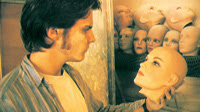Your greatest creation is the life you lead
Tarnation is an autobiographical documentary film about the very personal experience of growing up with a mother who was suffering from a schizoaffective disorder, an episodic illness in which both affective and schizophrenic symptoms are prominent within the same episode . It tells the story of three generations of a Texas family. The film was made in 2003 by Jonathan Caouette. He created a collage of still photos, Super-8 video tape, answering machine messages, video diaries and early short films, from the previous nineteen years of his life . It cost just over $200 to make the initial film. Some well-known producers, including Gus Van Sant, spent more money enhancing its technical qualities to bring it to a wider audience.


Tarnation is essentially a film of two parts. The first recounts the author's childhood and teenage years as affected not only by his mother's psychosis but also by her lengthy absences from his life when she was sometimes hospitalised for several years at a time. It tells of his first teenage experience with marijuana, obtained from a drug dealing friend of his mother, which was actually spiked with PCP, resulting in his first admission to hospital and the diagnosis of depersonalization disorder . A core symptom of this syndrome is a subjective experience of unreality, as if dreaming, in which the individual feels that his own feelings and/or experiences are detached, distant and not his own, a quality that the film definitely manages to convey at times. This part of the film also tells the story of his mother Renee's life from her early days as a beautiful child model to a teenager who embarks on a lengthy course of twice weekly Electroconvulsive therapy (ECT).


The second part of the film deals with the period after Jonathan has left the family home in Texas and moved to New York, where he meets his partner David and begins to work as an actor. His mother comes to visit him there a few years later and he begins to build an adult relationship with her more closely than ever before


The film uses intertitles to tell the facts of the story, speeded up sequences, slow motion frames, multiple images and other special effects to express his inner turmoil.As well as giving us an experience of Renee's mental illness, Tarnation also vividly depicts Caouette's own mental health struggles from drug induced hallucinatory experiences, depersonalization disorder and deliberate self-harm to anxiety and panic. Tarnation is a documentary film about the whole experience of mental illness from a very personal point of view that gives the viewer a real sense, affectively, of being in close proximity to significant mental disturbance. Tarnation doesn't hold back on portraying the pain and chaos that can be part of life where psychosis is present.


The act of making Tarnation could be described as 'creative play' involving the imaginative creation of the film as a transitional phenomenon that helps him to process the highly charged, difficult emotions that exist between him and his mother





























